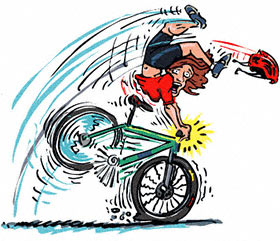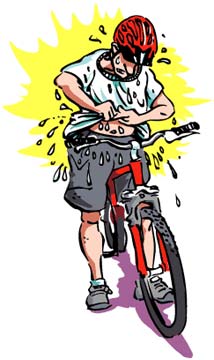
|
I may be a professional downhiller now, but when I was getting into cycling I made as many rookie mistakes as the next person. For example, during my first summer of cycling, there I was pounding out the miles on a training ride with one of our college coaches. Halfway through he looks over with this wry face and says, "You know Lisa, you really shouldn't wear underwear with cycling shorts." 'Hmmm... really?' I thought. 'That's kind of gross.' You think: A low seat gives me the ability to put both my feet on the ground, which makes me safer. Truth-of-the-matter: A seat this low is too low. It stresses your knees, can cause injury, inhibits proper balance and reduces your power. The right way: Raise your seat until when the balls of your feet are over the center of the pedals and the pedal is at the bottom of the stroke, you have a slight bent in your knee (illustration). You should be able to just touch the ground with your tip-toes. If you have any questions, just drop by your shop and they'll help you with this all-important adjustment.
Truth-of-the-matter: Because it's the more powerful brake, it IS possible to "endo" (illustration) if you apply it too hard or at the wrong time, however, not using your front brake drastically reduces your stopping power. So, you should use it a lot. The right way: It's best to always use both brakes. Yet, there are times, such as on steep downhills, when your front brake accounts for up to 90% of your stopping power and determines how much control you have. So it's important to practice and get good using it. An important tip is to shift your body rearward as you brake harder in front.
Truth-of-the-matter: Cotton's a great material to lounge around in. Once you start really riding, however, cotton holds onto every drop of perspiration leaving you soaked. Plus if the weather changes from warm and sunny to chilly, that wet tee will feel awful and could even cause chills and hypothermia. The right way: There's a reason cyclists wear what they do. Unlike tee shirts, jerseys feature wicking fabrics that actually keep you dry, warm and stink-free. Plus, they catch less air so it's easier to ride, and they often have built-in pockets for your identification, cash and energy food. You can also stuff a jacket in a pocket for use should the weather changes. If you try a jersey it's unlikely you'll ride in cotton again.
The right way: Shops feel as bad as you do when something breaks on your bike, and they want to help. Telling them a story puts them on the spot because they know it's not true. Instead, just tell them what happened and they'll do their best to make it right as soon as possible and at the best price possible because they want you out enjoying your bike again. You think: Yeah, my bike seems a little loose up front (or plug in your particular problem), but I want to ride, not take my bike in to get it checked! I'll just keep riding. Truth-of-the-matter: Bicycles are relatively simple machines, however, they can travel as fast as cars and you can get in trouble quick if something serious is wrong with your bike and you neglect it. The right way: Ride by the shop and have them take a look. They won't charge to do this and it could save you the costs of a more serious repair, or more importantly, prevent a dangerous crash. For example, in the case of that loose front end, it could save you a ruined frame and a loss of control on a downhill leading to a bad fall.
|


 You think: If I use my front brake, I'll go sailing over the handlebars.
You think: If I use my front brake, I'll go sailing over the handlebars. 
 You think: Okay, so maybe I shouldn't have run head on into that curb. But this is a mountain bike. It's supposed to hold up to anything. I'll tell the shop guy I was just riding along and WHAM! The wheel basically collapsed and broke.
You think: Okay, so maybe I shouldn't have run head on into that curb. But this is a mountain bike. It's supposed to hold up to anything. I'll tell the shop guy I was just riding along and WHAM! The wheel basically collapsed and broke. You think: The more lube I put on my chain, the better my bike will run.
You think: The more lube I put on my chain, the better my bike will run.
